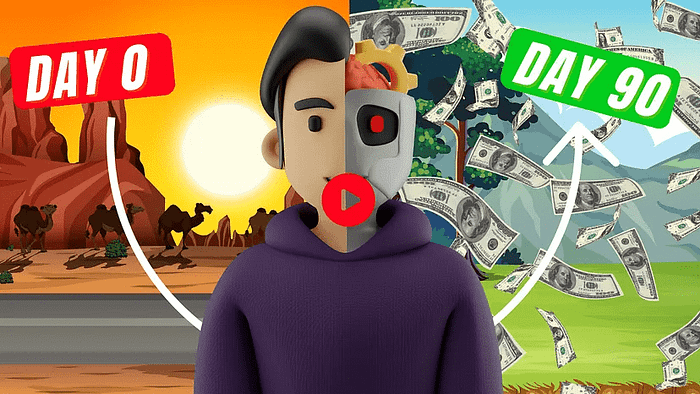7 Free AI Blogging Tools That Will Revolutionize Your Content Creation
Blogging has become an essential part of my online presence, and I’ve discovered that free AI blogging tools can significantly streamline the process. These innovative solutions have transformed my approach to content creation, making it more efficient and effective than ever before.
In this article, I’ll share my experiences with seven incredible free AI blogging tools that have revolutionized my writing workflow. Each of these tools offers unique features that cater to different aspects of the blogging process, from ideation to publication.
As we explore these powerful free AI blogging tools, I’ll provide insights into how they can enhance your content creation journey. Whether you’re a seasoned blogger or just starting out, these tools have the potential to elevate your writing and save you valuable time.
Let’s dive into the world of AI-powered blogging and discover how these free tools can transform your content strategy. By the end of this article, you’ll have a comprehensive understanding of how to leverage these free AI blogging tools to take your blog to new heights.
We strongly recommend that you check out our guide on how to take advantage of AI in today’s passive income economy.
ChatGPT: The Versatile AI Writing Assistant
ChatGPT has become an indispensable part of my blogging toolkit. This free AI blogging tool offers a wide range of capabilities that have significantly improved my content creation process.
One of the most valuable aspects of ChatGPT is its ability to generate content ideas. When I’m feeling stuck or need inspiration, I simply prompt the AI with a general topic, and it provides me with a wealth of creative suggestions.
Keyword research is another area where ChatGPT excels. By asking it to generate relevant keywords for my chosen topic, I can quickly build a list of SEO-friendly terms to incorporate into my content.
The writing assistance provided by ChatGPT is truly remarkable. It can help me craft compelling introductions, expand on key points, and even generate entire paragraphs based on my outline.
I’ve found that using ChatGPT as a brainstorming partner has greatly enhanced my creativity. By bouncing ideas off the AI, I often discover new angles and perspectives that I might not have considered otherwise.
While ChatGPT is an incredibly powerful tool, I always make sure to fact-check its output and add my own personal touch to ensure the content remains authentic and accurate.
Simplified: The All-in-One Content Creation Platform
Simplified has quickly become one of my favorite free AI blogging tools due to its comprehensive suite of features. This platform offers a range of AI-powered tools that cover various aspects of content creation.
The AI writer feature in Simplified has been particularly useful for generating blog post drafts. By inputting a brief description of my topic, the tool produces a well-structured outline that I can then expand upon.
One of the standout features of Simplified is its AI designer. This tool has helped me create eye-catching graphics and thumbnails for my blog posts, enhancing their visual appeal and shareability on social media.
The platform’s AI video generator has opened up new possibilities for repurposing my blog content. I can easily transform written posts into engaging video summaries, expanding my reach across different media formats.
Simplified’s social media AI has streamlined my promotion efforts. It generates tailored posts for various platforms, ensuring that my blog content reaches a wider audience.
The project management tools integrated into Simplified have helped me stay organized and on track with my content calendar. I can easily plan, schedule, and collaborate on blog posts all within the same platform.
While Simplified offers a range of premium features, I’ve found that the free version provides ample functionality to significantly improve my blogging workflow.
H-supertools: A Swiss Army Knife for Bloggers
H-supertools has become an essential part of my blogging arsenal, offering a diverse set of free AI blogging tools that cater to various aspects of content creation.
The content writer feature in H-supertools has been particularly helpful when I’m facing writer’s block. It generates well-structured paragraphs that serve as an excellent starting point for my blog posts.
One of my favorite features is the AI grammar checker. As someone who occasionally struggles with complex grammatical rules, this tool ensures that my writing is polished and error-free.
The AI translator in H-supertools has opened up new possibilities for reaching a global audience. I can easily translate my blog posts into different languages, expanding my readership beyond English-speaking markets.
H-supertools also offers an excellent keyword research feature. It helps me identify trending topics and relevant search terms, ensuring that my content aligns with what my audience is looking for.
While H-supertools provides a wealth of features, I always make sure to review and refine the AI-generated content to maintain my unique voice and ensure accuracy.
The user-friendly interface of H-supertools makes it easy to navigate between different tools, streamlining my workflow and saving me valuable time in the content creation process.
Pexels: Your Source for High-Quality Free Images
Although not strictly an AI tool, Pexels has become an integral part of my blogging process, providing me with a vast library of high-quality, copyright-free images to enhance my content.
When searching for the perfect image to complement my blog post, I simply enter relevant keywords into Pexels’ search bar. The platform then presents me with a curated selection of professional-grade photographs.
One of the things I appreciate most about Pexels is the diversity of its image library. Whether I’m writing about travel, technology, or lifestyle topics, I can always find visuals that perfectly capture the essence of my content.
Using Pexels has significantly improved the visual appeal of my blog. High-quality images not only make my posts more engaging but also help break up text and improve overall readability.
I’ve found that incorporating relevant images from Pexels can also boost my blog’s SEO performance. By using descriptive alt text and file names, I can signal to search engines what my content is about.
While Pexels offers a free service, I always make sure to credit the photographers when possible. This not only shows appreciation for their work but also builds goodwill within the creative community.
The platform’s user-friendly interface and fast loading times make it easy to quickly find and download the perfect images for my blog posts, saving me valuable time in the content creation process.
Grammarly: Your Personal Proofreader and Editor
Grammarly has become an indispensable tool in my blogging workflow, acting as a vigilant proofreader and editor for all my written content.
One of the most valuable aspects of Grammarly is its ability to catch subtle grammatical errors that I might otherwise miss. From comma placement to subject-verb agreement, it ensures my writing is technically sound.
The tool’s suggestions for improving clarity and conciseness have helped me refine my writing style. It often proposes alternative phrasings that make my content more engaging and easier to read.
I particularly appreciate Grammarly’s tone detector feature. It helps me maintain a consistent voice across my blog posts, ensuring that my writing aligns with my intended audience and purpose.
The vocabulary enhancement suggestions provided by Grammarly have expanded my word choice, adding variety and depth to my writing. This has been particularly helpful in avoiding repetition in longer posts.
While Grammarly is an incredibly useful tool, I always make sure to review its suggestions critically. Sometimes, I choose to retain certain phrasings for stylistic reasons, even if they don’t strictly adhere to grammatical rules.
The browser extension feature of Grammarly means I can use it seamlessly across various platforms, from my content management system to social media posts, ensuring consistency in all my online writing.
Canva: Unleash Your Inner Graphic Designer
Canva has revolutionized the way I approach visual content creation for my blog. This intuitive design tool has empowered me to create professional-looking graphics without any formal design training.
One of the features I love most about Canva is its vast library of templates. Whether I need a blog post header, an infographic, or a social media graphic, I can always find a suitable starting point.
The AI-powered features in Canva, such as the Background Remover and Magic Resize, have saved me countless hours. These tools allow me to quickly edit and repurpose images for different platforms.
I’ve found that Canva’s Brand Kit feature is incredibly useful for maintaining visual consistency across my blog. By saving my brand colors, fonts, and logos, I can ensure all my graphics have a cohesive look.
The platform’s extensive library of stock photos, illustrations, and icons means I rarely need to look elsewhere for visual elements. This all-in-one approach streamlines my design process significantly.
While Canva offers a range of premium features, I’ve found that the free version provides ample functionality for creating high-quality graphics for my blog.
The ability to collaborate with team members within Canva has been a game-changer for my blogging process. It allows for seamless feedback and iteration on design elements.
Answer the Public: Uncover Your Audience’s Burning Questions
Answer the Public has become my go-to tool for understanding what my audience really wants to know about a given topic. This invaluable resource has transformed my approach to content planning.
When I input a keyword or topic into Answer the Public, it generates a comprehensive list of questions that people are actually searching for online. This insight helps me create content that directly addresses my audience’s needs.
One of the features I appreciate most about Answer the Public is its visual representation of data. The wheel format provides an at-a-glance view of the most common question types related to my chosen topic.
I’ve found that using Answer the Public at the beginning of my content creation process helps me structure my blog posts more effectively. By addressing the most pressing questions, I ensure my content is highly relevant and valuable.
The tool’s ability to generate long-tail keywords has been instrumental in improving my SEO strategy. These specific phrases often have less competition, making it easier for my content to rank well in search results.
While Answer the Public is not strictly an AI tool, its data-driven approach to content ideation aligns perfectly with my use of other free AI blogging tools.
I always make sure to cross-reference the insights from Answer the Public with other keyword research tools to get a comprehensive view of my topic’s search landscape.
Conclusion: Embracing the Future of Blogging with AI
As we’ve explored in this article, free AI blogging tools have the potential to revolutionize the way we approach content creation. From generating ideas to polishing our final drafts, these tools offer invaluable assistance at every stage of the blogging process.
ChatGPT, Simplified, H-supertools, Pexels, Grammarly, Canva, and Answer the Public each bring unique strengths to the table. By integrating these free AI blogging tools into your workflow, you can significantly enhance your productivity and the quality of your content.
However, it’s important to remember that these tools are meant to augment, not replace, your creativity and expertise. The most compelling content still comes from your unique perspective and experiences.
As AI technology continues to evolve, we can expect even more sophisticated free AI blogging tools to emerge. Staying informed about these developments will be crucial for bloggers who want to remain competitive in the digital landscape.
I encourage you to experiment with these free AI blogging tools and find the combination that works best for your specific needs. With practice and refinement, you’ll develop a streamlined workflow that allows you to create high-quality content more efficiently than ever before.
Remember, the goal of using free AI blogging tools is not just to save time, but to free up your mental energy for the creative aspects of blogging that truly set your content apart.
By embracing these powerful free AI blogging tools, you’re positioning yourself at the forefront of the blogging revolution. Here’s to creating exceptional content and building a thriving blog in the age of AI!
Frequently Asked Questions:
Is there an AI that writes blogs for free?
Yes, there are several AI tools that offer free blog writing capabilities. ChatGPT, one of the most versatile free AI blogging tools, can generate blog content at no cost. While it doesn’t write entire blogs autonomously, it provides substantial assistance in drafting, outlining, and expanding ideas.
Other free AI blogging tools like Simplified and H-supertools also offer content generation features in their free tiers. These tools can help create blog post drafts, outlines, and even full paragraphs based on your input.
It’s important to note that while these free AI blogging tools are incredibly helpful, they should be used as writing aids rather than complete replacements for human creativity and expertise. The best results come from combining AI assistance with your own knowledge and writing style.
Which AI tool is best for blog writing?
Determining the best AI tool for blog writing depends on your specific needs and preferences. However, based on my experience with free AI blogging tools, here are some top contenders:
- ChatGPT: Excellent for brainstorming, outlining, and generating content ideas.
- Simplified: Great for creating full blog post drafts and complementary visuals.
- Grammarly: Invaluable for proofreading and enhancing writing quality.
- H-supertools: Offers a wide range of features including content generation and SEO optimization.
Each of these free AI blogging tools excels in different areas of the writing process. I’ve found that using a combination of these tools often yields the best results, allowing me to leverage their individual strengths throughout my blogging workflow.
Remember, the “best” tool often comes down to personal preference and writing style. I recommend experimenting with various free AI blogging tools to find the one that aligns best with your needs.
Is there any free AI writing tool?
Absolutely! There are several free AI writing tools available that can significantly enhance your blogging process. Some of the most popular free AI blogging tools include:
- ChatGPT: Offers a wide range of writing assistance features.
- Simplified: Provides content generation and design capabilities in its free tier.
- H-supertools: Offers various writing and SEO tools at no cost.
- Grammarly: Provides essential grammar and style checking for free.
- Canva: Offers AI-powered design features in its free version.
These free AI blogging tools can help with various aspects of content creation, from generating ideas to polishing your final draft. While they often have premium versions with additional features, their free tiers typically offer substantial value for bloggers.
It’s worth noting that while these tools are free to use, they may have certain limitations such as usage caps or restricted features. Always check the terms of service to understand what’s included in the free version.
Can I use AI for blogging?
Yes, you can absolutely use AI for blogging, and many successful bloggers are already incorporating free AI blogging tools into their workflows. AI can assist with various aspects of the blogging process, including:
- Content ideation and research
- Outlining and structuring blog posts
- Writing drafts and generating paragraphs
- Proofreading and grammar checking
- SEO optimization
- Creating visuals and graphics
Free AI blogging tools like ChatGPT, Simplified, and H-supertools can help streamline your content creation process, making it more efficient and often improving the quality of your output.
However, it’s crucial to remember that AI should be used as a tool to enhance your blogging, not replace your unique voice and expertise. The most compelling blogs still rely on human creativity, personal experiences, and original insights.
When using AI for blogging, always review and edit the generated content to ensure it aligns with your style and meets your quality standards. Also, be aware of any ethical considerations or disclosure requirements in your niche regarding the use of AI-generated content.
By thoughtfully integrating free AI blogging tools into your process, you can create high-quality content more efficiently, allowing you to focus on the strategic and creative aspects of blogging that truly set your work apart.

We strongly recommend that you check out our guide on how to take advantage of AI in today’s passive income economy.




